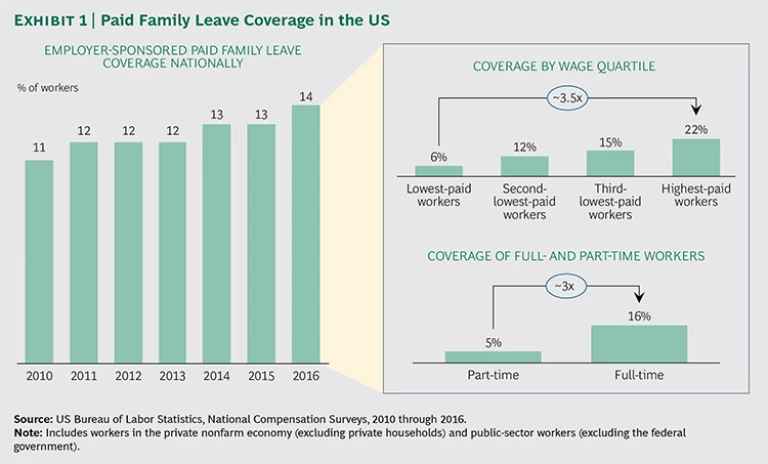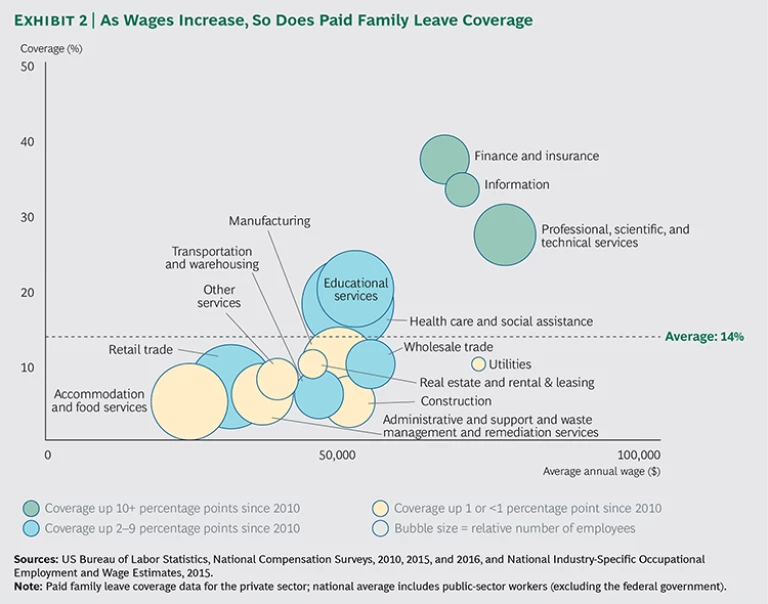A growing number of companies are moving to provide paid family leave for their US employees—and they're not all in industries you might expect. In addition to technology, financial services, and professional services firms, such organizations include food and beverage manufacturers, retail and food services companies, and even the US Department of Defense. And while paid family leave has traditionally been available only to birth mothers, companies are now making their policies much more expansive (covering all types of employees) and inclusive (covering all parents, all types of families, and a variety of personal events, such as the illness of a family member).
Why the shift? To answer this question BCG reviewed the policies of more than 250 companies and interviewed 25 HR leaders at large organizations. Our finding: employers see a solid business case for offering paid family leave, including benefits such as improved talent retention and attraction and their own ability to manage the costs of the program through thoughtful policy design.
The Changing Dynamics of Paid Family Leave
The US is one of just eight countries—and the only member of the Organisation for Economic Co-operation and Development—with no national policy mandating paid maternity leave for workers. To date, only three US states (California, New York, and Rhode Island) have implemented paid family leave programs, and five states (California, Hawaii, New Jersey, New York, and Rhode Island) guarantee workers' access to paid temporary disability leave In the rest of the country, the only related benefit is provided by the Family and Medical Leave Act, which ensures 12 weeks of job protection—but not pay—for some employees of companies with a workforce of more than 50. Meanwhile, there is widespread consensus on the benefits of the policy for workers and their families, including improved health for children and higher wages for working mothers.
Absent a federal paid family leave policy, it is primarily employers that determine whether employees have access to paid time off to care for a new child or an ill family member. The result: only 14% of the US workforce has access to employer-sponsored paid family leave. Coverage has increased just 3 percentage points, from 11% to 14%, since 2010, and coverage is concentrated among certain segments of workers. Workers in the highest income quartile are three and a half times more likely to have access to paid family leave than those in the lowest income quartile. Similarly, coverage is three times greater among full-time workers than among part-time workers. (See Exhibit 1.)
These disparities are particularly noteworthy because—while all employees stand to benefit from paid family leave policies—low-income and part-time employees are likely to gain the most.
Demand Is Increasing
Three shifts have caused an uptick in demand for paid family leave policies. First, far fewer families have a stay-at-home parent who can care for a newborn or newly adopted child or an ill family member. Second, the increasing participation of women in the workforce has contributed to changes in caregiving and particularly in parenting, with men taking a more hands-on role. Third, an increasing portion of the workforce is helping to care for aging parents—a trend that is only expected to intensify.
The bottom line: there are fewer households with a full-time caregiver, both parents are increasingly involved in caring for their children, and the burden of caregiving overall is growing.
Diverse Industries Are Responding
The movement to offer or expand paid family leave began in industries such as technology, financial services, and professional services, where competition for small pools of talent, and hence salaries, are both high. For example, according to data from the Bureau of Labor Statistics, paid family leave coverage in finance, insurance, and information, as well as in professional, scientific, and technical services, grew by more than 10 percentage points from 2010 to 2016. While coverage is still low even in these sectors—no more than 40% in 2016—the percentage of workers able to take advantage of such policies is significantly higher than in other industries. (See Exhibit 2.)
Over the past two years, however, paid family leave has begun to gain ground in sectors with lower average wages, such as manufacturing, accommodation and food services, and retail. The policies now offered by Hilton, Union Square Hospitality Group, and IKEA, among others—as well as by companies in technology, financial services, and professional services—also tend to be more equitable and generous than those that were typically offered in the past. Many provide equal time off to men and women, and most also cover their entire US workforce—that is, both hourly and salaried workers, regardless of job function.
The Business Case for Paid Family Leave
While it's not a surprise that paid family leave is good for workers, we found that these policies deliver significant business rewards as well:
- Employee Retention. Talent retention is one of the primary reasons cited by employers to provide paid family leave. According to one study, women who take paid leave are 93% more likely to be in the workforce 9 to 12 months after a child's birth than women who take no leave.
11 1 Linda Houser and Thomas Vartanian, "Pay Matters: The Positive Economic Impacts of Paid Family Leave for Families, Businesses and the Public," Rutgers Center for Women and Work, January 2012 And paid leave makes it more likely that women will return to work for the same employer. When Google, for example, increased its paid maternity leave program from 12 to 18 weeks, the rate of female turnover after maternity leave was reduced by 50%. Studies show that these retention benefits hold for low-wage workers as well. - Talent Attraction. As demand grows for paid family leave, it's not surprising that such policies are an increasingly popular differentiator for companies. Indeed, in a 2016 survey by Deloitte, 77% of workers with access to benefits reported that the amount of paid parental leave had some influence on their choice of one employer over another. 2 And as more and more employers provide paid family leave, they create pressure on others to do the same.
- Reinforced Company Values. For many companies, expanding paid family leave is driven by a set of values and a desire to reinforce them throughout the organization. Paid family leave can, for example, signal a company's commitment to its employees. Further, it can enable a company to show its support for diversity and equality through policies that are gender neutral, that provide leave to care for sick family members, and that cover same-sex couples, adoption, surrogacy, or foster care.
- Improved Engagement, Morale, and Productivity. The companies we studied emphasized that providing paid family leave translates into better employee engagement, morale, and productivity. A 2016 EY study of more than 1,500 employers backs this up, finding that more than 80% of companies that offer paid family leave reported a positive impact on employee morale, and more than 70% reported an increase in employee productivity.
3 3 EY, Paid Family and Medical Leave Survey, 2016 (unpublished). Note that the vast majority (97% and 93%) reported a positive or no effect on morale and productivity, respectively, suggesting that very few companies experienced any negative effect. - Enhanced Brand Equity. Improving paid leave often throws the media spotlight on a company. The day after IKEA enhanced its policy, it saw coverage in such outlets as the Wall Street Journal, Fortune, Forbes, and the Washington Post, among many others. Other companies, including Hilton, likewise received significant media attention after announcing a paid family leave policy, coverage that continued well after the initial announcement. Notably, both Hilton and IKEA announced something that was new for their industries, suggesting that there is a halo effect for those that take an early position on this issue or design their policies in an innovative way.
The Tradeoff Between Costs and Benefits
In EY's study, companies without a paid family leave policy cited cost as their principal concern in adopting one. So what do companies that have implemented such policies say?
First, companies report that the rewards outweigh the costs, particularly compared with those of other benefits they could provide. Given the difficulty of quantifying the benefits of a paid family leave policy, few of the companies we studied relied on a pure economic calculation when making their decision. That said, empirical evidence does suggest that among companies that have implemented such policies, paid family leave has generally helped or had no effect on their bottom line. In EY's study, for example, 92% of companies with a paid family leave policy reported that it had a positive effect or no effect on profitability. At the same time, the retention benefits of paid family leave can offset its costs. Those costs vary widely by industry, but a 2012 review found that replacing an employee typically costs around 21% of his or her salary.
Second, companies with paid family leave policies have been able to manage the costs of their programs through thoughtful design. Many of the company HR leaders we spoke with—and particularly those outside of the technology, professional services, and financial services industries—stressed that they focused on a few key requirements, such as covering their entire workforce or making the policy available to all types of families, including adoptive parents or same-sex couples. They then adjusted the number of weeks, the level of wage replacement, or the flexibility of the policy to fit their business. In this way, they designed policies that met their business context as well as their workforce needs.
Lessons from the Leaders
Deciding to offer paid family leave is only the first step. The company then has to design the program, ensure a successful implementation, and track outcomes such as usage rates, costs, and benefits. Our research suggests that there are five main imperatives in designing a paid family leave policy:
- Reflect the company's values. The design of a paid family leave program—especially its inclusiveness—says a lot about what a company stands for. Companies must first determine how the policy will distinguish—if at all—among parents. For example, will male and female or same-sex couples have the same coverage? Then they must decide which categories of employees, such as part-time or hourly workers, will be covered. Finally, which caregiving needs will be covered? While many companies are still offering only parental leave, some have expanded coverage to include paid leave to care for an ill family member.
- Remember that weeks off are not the only value driver. Of the more than 60 companies we reviewed that have changed their paid family leave policies in the last two years, most are offering more time off. That said, duration is only one source of value. A policy that gives employees flexibility in when they take their leave, for example, may be of greater value than a more rigid policy that offers a longer leave. Flexibility may mean allowing employees to take nonconsecutive weeks off, or providing either full pay for a certain number of weeks or half-pay for a period twice as long.
- Set an example at the top. Even the best-designed policy will not have an impact if employees don't feel comfortable taking advantage of it. This may be a particular risk with paternity and caregiver leave, which are less likely than maternity leave to be widely accepted in the workplace. Strong signals—such as ensuring that those in leadership positions take time off when they need it—can make a difference.
- Develop support systems. Employee absences can be disruptive—both for those going on leave and for those covering for them—if not handled appropriately. There are several ways to address this challenge, such as creating smooth off and on ramps for workers about to take leave or returning to work. Companies should also consider how to support managers and those covering for employees on leave. Support systems can include a checklist outlining what managers need to do when an employee goes on leave or regular communications between HR and the covering employees.
- Choose metrics to measure success. Numerous metrics related to paid family leave can be collected, but we recommend a short list that can be used to quickly assess a program. This includes statistics on who is taking paid time off and for how long, as well as temporary labor replacement costs, data on benefits such as retention rates for employees who have taken leave, and survey data on employee perceptions of the program.
Certainly, not every organization will conclude that it makes sense to cover the costs of paid family leave, and a national policy would almost certainly be required to provide full and equal access to the benefit for all US workers. Those companies that do provide paid time off, however, stand to gain significant benefits. They will likely see employees more willing to remain with the company, reducing turnover costs and potentially increasing the diversity of leadership teams. They may be able to attract more talented workers. And they may also find that a more generous paid family leave policy helps translate the organization's values into action, enhancing internal engagement and the company's brand.
The full version of this report can be downloaded here .










